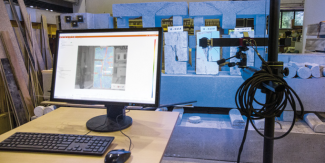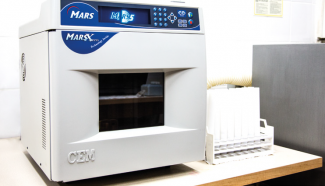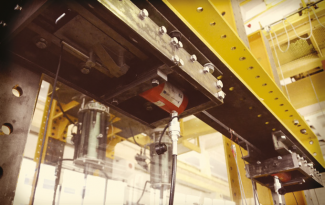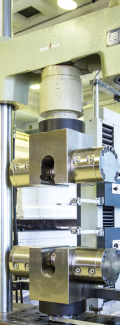Method of wind turbine revitalization.
The first comprehensive method for revitalization of a wind turbine in the world, developed by the Department of Structural Mechanics, changing the application and expanding its functionality to include a lookout tower and educational elements.

The Department of Structural Mechanics has developed a method of revitalizing disused wind turbines and extending their functionality. The invention combines an innovative way of strengthening the existing structure of a revitalized wind turbine with a change of the rotor type from a horizontal rotary axis rotor to a rotor with a vertical axis. This provides noise reduction and the possibility of commercial use of the structure as an observation deck. This method of wind turbine revitalization will be of interest to wind energy companies.
Measuring the vibration frequency of engineering objects, the excitation of vibrations of a desired frequency, dynamic analysis of building structures.

Monitoring and reference of velocities/accelerations in an object under dynamic load to standard values. Expert opinions on dynamically loaded building structures.
The dynamic effects of machines can be a source of loads that affect the structure and its neighbouring objects. The long-term nature of these interactions can cause the displacement or velocity values to be exceeded and, as a consequence, can lead to a construction disaster. The goal of the measurement is to monitor these quantities.
The service prepared by the Department of Structural Mechanics is addressed to real estate developers and users of buildings subjected to dynamic activities.
Reinforcing of existing structures with gradient method FRP polymer composites.
Innovative composite materials for reinforcing existing infrastructure.

The service proposed by the Concrete Construction Department can be used to increase the load capacity of buildings destined for changed functions or to counteract the absence of load capacity caused by failure of structural elements or design errors. Composite materials are resistant to aggressive external environments. They do not corrode.
This offer will be of interest to construction companies as well as to public and private investors.
Assays of heavy metal contents in liquid samples using the ASA method.
Assaying of trace substance concentrations, including, among others, heavy metals, requires the application of highly sensitive methods.

The Institute of Environmental Engineering and Building Installations offers laboratory services associated with assaying heavy metal contents. Atomic Absorption Spectrometry (ASA or AAS) is an analytical technique which allows for assaying elements (primarily metals) in liquid, solid and gaseous samples. The measurement principle is based on the absorption of specific wavelength radiation by free metal atoms.
This service will be of interest to businesses involved in industrial processing, waste and sewage management and reclamation related activities.
Reinforcing existing structures using stressed FRP polymer composites pasted into a concrete cover (Near Surface Mounted – NSM method).
Innovative technology for strengthening reinforced concrete and masonry structures using stressed CFRP composite materials glued into grooves cut out in the structural elements of existing buildings.

Research carried out by the Concrete Construction Department proved that the effectiveness of the NSM system is over 100% higher than that of common commercial prestressing systems for EBR reinforcements. It can be used when increasing the load-bearing capacity of building structures intended for changed functions and when working on historic buildings, where the presence of reinforcements cannot be visible.
Composite materials are resistant to the external environment. They do not corrode. This service will be of interest to construction companies as well as to public and private investors.
Construction of new concrete structures using FRP (Fiber Reinforced Polymer) non-metallic reinforcement.

Innovative composite materials for non-metallic reinforcement made of composite fibres.
Composite rods are used in structures subject to the effects of an aggressive environment that causes corrosion (e.g. marine environments, aggressive chemical environments) or in the underground elements of buildings. An important feature of non-metallic reinforcement is its resistance to magnetic fields which makes it possible to use it in magnetic rail systems, the foundations of large engines and in magnetic scanning systems.
This service prepared by the Concrete Construction Department will be of interest to construction companies as well as to public and private investors.
